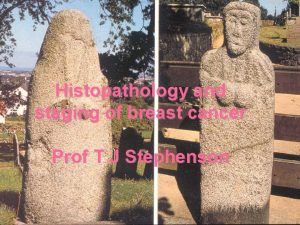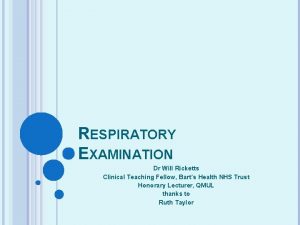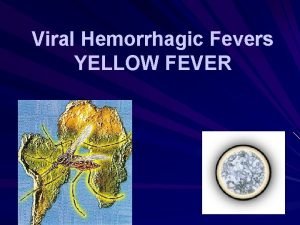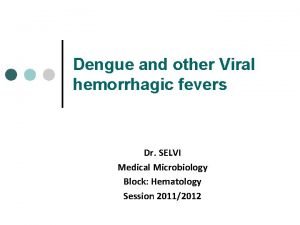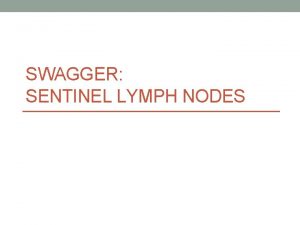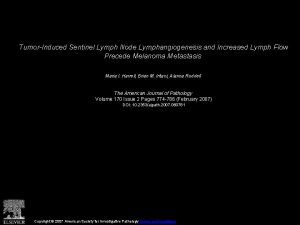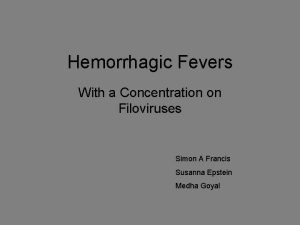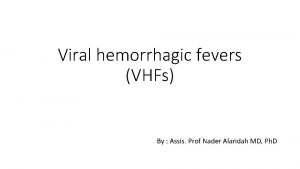Tutorial Topics Lymph node syndromeDengue other hemorrhagic fevers











- Slides: 11

Tutorial Topics: Lymph node syndrome/Dengue & other hemorrhagic fevers Block: Hematology (HEM) MBBS Year 1 Semester 2 Session 2011/2012 Lecturer-in-charge: HK/PS 4 th June 2012

1. The following statements are TRUE/FALSE: F A. Chronic fatigue syndrome is primarily a disorder of elderly males. F B. T C. Cytomegalovirus and herpes simplex virus are usually implicated in chronic fatigue syndrome. Patients with chronic fatigue syndrome tend to develop paradoxical bradycardia and syncope. T D. F E. Impairment in short-term memory is one of the presentations of chronic fatigue syndrome. Blood culture helps in the diagnosis of chronic fatigue syndrome.

2. The following statements are TRUE/FALSE: T A. Kawasaki syndrome is an acute vasculitis that primarily affects infants and young children. T B. T C. Staphylococcal enterotoxins may be associated with Kawasaki syndrome. Strawberry tongue with small haemorrhagic fissures are the clinical manifestations of Kawasaki syndrome. F D. T E. Diagnosis of Kawasaki syndrome is based on the decreased levels of bilirubin and alkaline phosphatase. Aspirin is used in the treatment of acute phase of Kawasaki syndrome.

3. T T The following statements are TRUE/FALSE: A. Transfusion-transmitted cytomegalovirus disease is usually seen in immunocompromised hosts. B. The clinical presentations of neonatal cytomegalovirus infections include hepatomegaly, petechiae and thrombocytopenia. Guillain-Barre syndrome and Bell’s palsy are among the complications of CMV mononucleosis. CMV infection is diagnosed based on positive heterophile antibody. T C. F D. T E. Ganciclovir is used in the treatment of CMV infections.

4. The following statements are TRUE/FALSE: T A. EBV replicates in epithelial cells of the oropharynx. T B. T C. Infectious mononucleosis usually presents with lymphadenopathy and fever. Autoimmune hemolytic anemia is one of the complications of infectious mononucleosis. F F D. E. Detection of pp 65 in circulating lymphocytes is used as a diagnostic tool for infectious mononucleosis. Treatment of infectious mononucleosis includes the administration of anti-viral agents.

5. The following statements are TRUE/FALSE: T A. EBV infection is usually transmitted through contact of saliva from an infected person. T B. Patients with infectious mononucleosis may develop distinct diffuse maculopapular rash following administration of ampicillin. T C. Oral hairy leukoplakia is one of the complications of EBV infections in HIV positive patients. F D. Tissues infected with EBV exhibit a typical enlarged cell with “owl’s eye” basophilic nuclear inclusion. E. The presence of large atypical lymphocytes with abundant, basophilic, vacuolated cytoplasm is a hallmark of infectious mononucleosis. T

6. The following statements are TRUE/FALSE: F A. Chikungunya hemorrhagic fever is caused by a flavivirus and is transmitted by rat bites. T B. Rats are the reservoirs of Hantaan virus. T C. F D. T E. Hantaan virus is the causative agent of Korean hemorrhagic fever. Marburg and Ebola viruses which belong to the genus Arenavirus cause self-limiting disease. Both dengue and yellow fever are caused by flaviviruses and are transmitted by mosquitoes.

7. T T The following statements are TRUE/FALSE: A. Dengue virus consists of more than one serotype. B. The principal vector of dengue fever in the rural and urban areas are different. Fever, retro-orbital pain and myalgia with deep bone pain are clinical features of dengue fever. T C. F D. F E. Dengue virus replicates in hepatocytes and also in vascular endothelium. After an earlier attack of dengue, antibodies formed against one serotype are protective against all other serotypes.

8. The following statements are TRUE/FALSE: F A. Antibody to dengue virus serotype 1 binds to dengue virus serotype 2 and thus neutralize the infection by serotype 2. T B. Vascular damage, shock and hemorrhage are due to an increased release of cytokines into the circulation. T C. Saddleback pattern of fever is observed in dengue fever. Gastrointestinal bleeding is one of the manifestations of dengue hemorrhagic fever. T F D. E. Leucocytosis with predominant polymorphs is a feature of dengue fever.

9. The following statements are TRUE/FALSE: T A. Dengue hemorrhagic fever occurs following reinfection with a dengue virus of different serotype after the primary attack. T B. A narrow pulse pressure of less than 20 mm Hg is a feature of dengue shock syndrome. C. Dengue virus can be isolated by intracerebral inoculation of the clinical specimen in Aedes albopictus larvae. F D. F E. In secondary infection, Ig. G is significantly raised and Ig. M is always negative. Dengue and yellow fever viruses are antigenically related and usually provide cross-immunity. T

10. The following statements are TRUE/FALSE: T T T F A. Yellow fever virus is a flavirus with one antigenic type. B. Jungle yellow fever is transmitted from infected monkeys to human by bites of Haemogogus sp. C. Live attenuated 17 D yellow fever vaccine provides 95% protection for 10 years. D. Hantavirus pulmonary syndrome is caused by Prospect Hill virus and is usually a self-limiting disease. Hemorrhagic complications of Chikungunya fever are more commonly seen among Europeans. E. F
 Lymph tends to stall inside lymph nodes. this is due to
Lymph tends to stall inside lymph nodes. this is due to Lymph tends to stall inside lymph nodes
Lymph tends to stall inside lymph nodes Interpectoral lymph node
Interpectoral lymph node Lymph node diagram
Lymph node diagram Upper limb venous drainage
Upper limb venous drainage Sinus vs fistula
Sinus vs fistula Epitrochlear lymph node
Epitrochlear lymph node Decreased tactile fremitus
Decreased tactile fremitus Lymph node dissection
Lymph node dissection Vaginal hydrocele
Vaginal hydrocele Sentinel lymph node biopsy indications
Sentinel lymph node biopsy indications Superficial lymph nodes abdomen
Superficial lymph nodes abdomen


